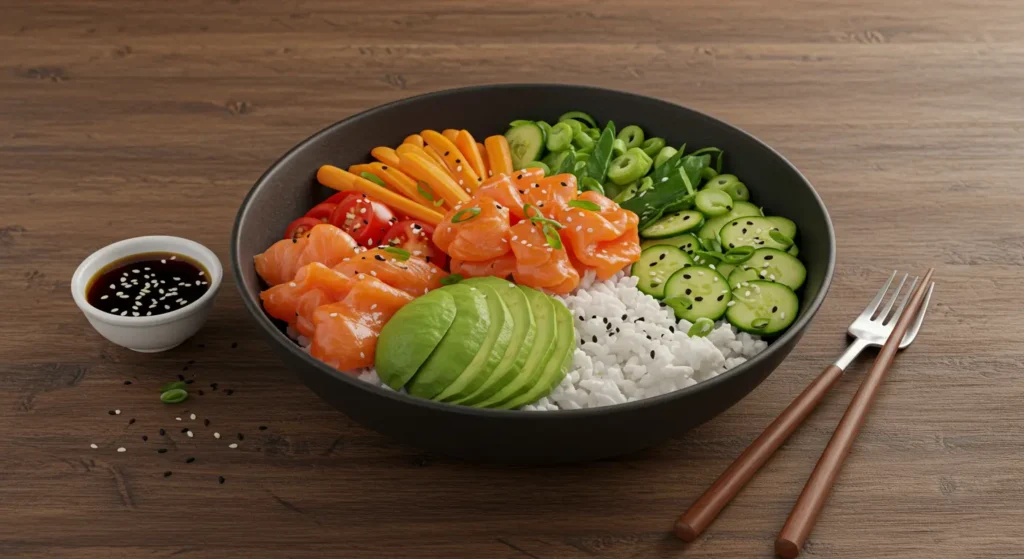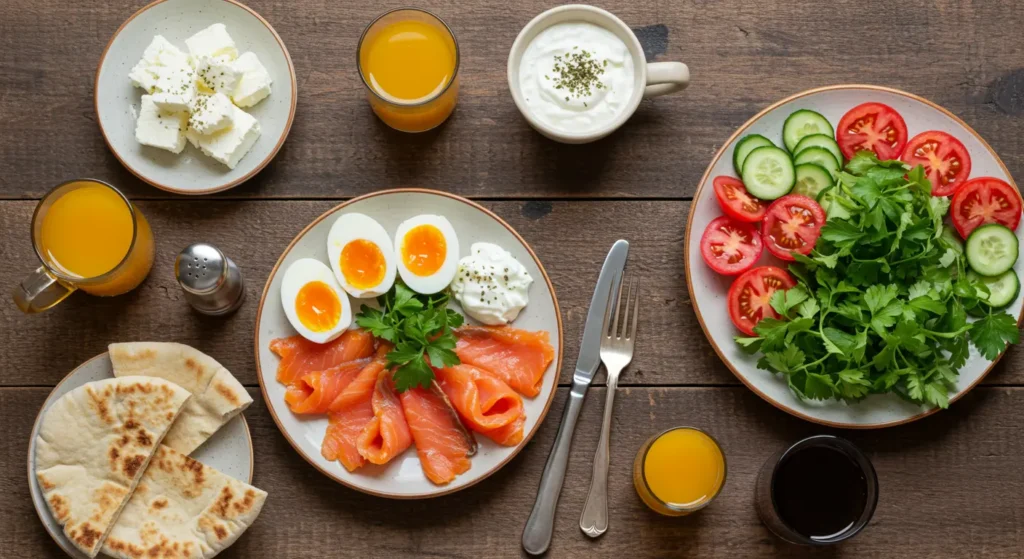Smoked Salmon – Why This Recipe?
As Chef Greeny, I’ve always had a special connection with smoked salmon. My love affair with this delicacy began during my culinary apprenticeship in the Pacific Northwest, where I witnessed firsthand the traditional smoking techniques that transform fresh salmon into something truly magical. The rich, buttery texture combined with that distinctive smoky flavor creates a versatile ingredient that elevates any dish it touches.
What makes smoked salmon so special is its perfect balance of flavors—smoky, salty, and slightly sweet—making it an ideal addition to everything from breakfast platters to elegant dinner party appetizers. In this article, I’ll share my favorite smoked salmon recipes, including some unique twists that will surprise even the most experienced food enthusiasts.
By the end of this post, you’ll not only learn how to prepare smoked salmon in various delicious ways but also understand its nutritional benefits, cultural significance, and creative variations to suit different dietary preferences.
Smoked Salmon – Ingredients and Preparation
Ingredients List

For classic smoked salmon crostini (serves 4):
- 8 oz premium smoked salmon, thinly sliced
- 1 French baguette, cut into 1/2-inch slices (about 20 pieces)
- 4 oz cream cheese, softened (substitute with dairy-free cream cheese for lactose-intolerant options)
- 2 tablespoons fresh dill, chopped, plus extra for garnish
- 1 tablespoon capers, drained and roughly chopped
- 1 small red onion, thinly sliced
- 1 tablespoon fresh lemon juice
- 2 tablespoons extra virgin olive oil
- 1 teaspoon black pepper, freshly ground
- Salt to taste
- Optional: 1 tablespoon horseradish for extra kick
Substitution options:
- For gluten-free: Use gluten-free crackers or cucumber rounds instead of baguette
- For dairy-free: Try cashew cream cheese or avocado spread
- For low-carb: Use cucumber slices or endive leaves as the base
Step-by-Step Instructions
- Prepare the base: Preheat oven to 375°F (190°C). Brush baguette slices lightly with olive oil on both sides. Arrange on a baking sheet and toast until golden brown, about 5-7 minutes. Set aside to cool. Tip: Watch the bread closely as it can go from perfectly toasted to burned quickly.
- Make the spread: In a small bowl, mix softened cream cheese with 1 tablespoon of chopped dill, half of the capers, a squeeze of lemon juice, and black pepper to taste. Blend until smooth and evenly combined. Tip: Allow cream cheese to come to room temperature for easier mixing and spreading.
- Assemble the crostini: Spread a generous layer of the cream cheese mixture on each cooled toast. Layer with a slice of smoked salmon, folding it to create height and texture. Tip: Don’t overload the crostini—balance is key for the perfect bite.
- Add finishing touches: Top each crostini with a few slices of red onion, the remaining capers, and a sprinkle of fresh dill. Drizzle with a little olive oil and add a final squeeze of lemon juice just before serving. Tip: For a more refined presentation, pickle the red onions briefly in a mixture of vinegar, sugar, and water.
- Serve immediately: Arrange on a serving platter and enjoy at room temperature. Tip: These are best assembled just before serving to maintain the crisp texture of the toast.
Notes and Tips
- Storage: While best enjoyed immediately, the cream cheese spread can be made up to 24 hours in advance and stored in an airtight container in the refrigerator.
- Serving suggestions: Pair with a crisp white wine like Sauvignon Blanc or a light Champagne. These crostini make perfect appetizers for brunches or evening gatherings.
- Make-ahead instructions: Toast the bread and prepare all components separately up to 4 hours ahead, then assemble just before serving to prevent sogginess.
- Quality matters: Since smoked salmon is the star of this dish, invest in high-quality product from a reputable source for the best flavor and texture.
Smoked Salmon – Nutritional Information
Nutrition Facts (Per Serving – 5 crostini)
- Calories: (~220)
- Carbohydrates: (18g)
- Protein: (12g)
- Total Fat: (12g)
- Saturated Fat: (4g)
- Unsaturated Fat: (7g)
- Trans Fat: (0g)
- Fiber: (1g)
- Sugar: (1g)
- Cholesterol: (30mg)
- Sodium: (650mg)
Smoked salmon is particularly high in omega-3 fatty acids, which support heart and brain health. It’s also an excellent source of high-quality protein, B vitamins (particularly B12), and selenium. The moderate sodium content comes primarily from the smoking process, so those on sodium-restricted diets should enjoy in moderation.
Smoked Salmon – History and Cultural Significance
Smoking salmon as a preservation method dates back thousands of years, with Indigenous peoples of the Pacific Northwest pioneering techniques to preserve their abundant salmon harvests. Traditional methods involved slow-smoking the fish over alder or cedar wood fires, a process that not only preserved the salmon but also imparted distinctive regional flavors.
In European cuisine, particularly in Nordic countries like Norway and Sweden, smoked salmon holds a special place in cultural celebrations and everyday meals. The gravlax technique—curing salmon with salt, sugar, and dill—represents a close cousin to the smoking method and has been practiced since the Middle Ages.
In Jewish cuisine, lox (derived from the Yiddish word for salmon) has become an iconic component of the classic “bagel and lox” combination, particularly popular in New York City delis and now recognized worldwide.
Each culture has developed its own unique approach to smoking salmon:
- Scottish cold-smoked salmon tends to be more delicate with a mild smoke flavor
- Pacific Northwest hot-smoked salmon has a flakier texture and bolder taste
- Scandinavian smoked salmon often incorporates dill and aquavit in the curing process
- Japanese sake-infused smoked salmon offers subtle umami notes

Smoked Salmon – Creative Variations
1. Asian-Inspired Smoked Salmon Rice Bowls
Transform your smoked salmon into a nutritious and satisfying meal with this fusion rice bowl:
- Base: Warm brown rice or cauliflower rice (for low-carb option)
- Protein: Sliced smoked salmon (3-4 oz per serving)
- Vegetables: Sliced avocado, cucumber, shredded carrots, radish
- Toppings: Seaweed strips, sesame seeds, green onions
- Dressing: Mix 2 tablespoons soy sauce (or tamari for gluten-free), 1 tablespoon rice vinegar, 1 teaspoon sesame oil, and 1/2 teaspoon grated ginger
This variation works wonderfully for meal prep—prepare components separately and assemble just before eating.
2. Mediterranean Smoked Salmon Breakfast Board
Create a stunning weekend brunch centerpiece with this Mediterranean-inspired spread:
- Smoked salmon (4-6 oz, artfully arranged)
- Soft-boiled eggs (or scrambled for a kid-friendly option)
- Greek yogurt spread (mix 1 cup Greek yogurt with lemon zest, olive oil, salt, and herbs)
- Sliced tomatoes, cucumber, and red onion
- Olives and capers
- Fresh herbs (dill, parsley, mint)
- Warm pita bread or sourdough toast
This family-style presentation encourages interactive dining and can be easily adapted for vegan guests by including hummus and plant-based yogurt alternatives.
Smoked Salmon – Frequently Asked Questions

Can I freeze smoked salmon?
Yes, smoked salmon can be frozen for up to 3 months. For best results, wrap it tightly in plastic wrap, then place in a freezer bag with all air squeezed out. Thaw overnight in the refrigerator before using. Note that the texture may change slightly after freezing, making previously frozen smoked salmon better suited for cooked applications rather than being served cold.
What can I substitute for capers in smoked salmon recipes?
If you don’t have capers or don’t enjoy their flavor, chopped green olives, finely diced cornichons (small pickles), or even a small amount of chopped preserved lemon can provide a similar salty, tangy flavor profile. For a milder option, try finely chopped fresh herbs with a squeeze of lemon juice.
How long does smoked salmon last in the refrigerator?
Properly stored in its original packaging or tightly wrapped in plastic wrap, smoked salmon typically lasts 1-2 weeks in the refrigerator. Once opened, it’s best consumed within 3-5 days. Look for any signs of sliminess, off-odors, or discoloration as indicators that the salmon should be discarded.
Is smoked salmon cooked or raw?
This depends on the type of smoked salmon. Cold-smoked salmon (the most common type, with thin, silky slices) is cured but not technically cooked, as the smoking temperature remains below 90°F. Hot-smoked salmon is fully cooked at temperatures around 120-180°F, giving it a flakier texture similar to baked salmon. Both types are safe to eat without further cooking due to the preservative effects of the salt curing process.
Smoked Salmon – Final Thoughts
Smoked salmon represents the perfect marriage of traditional preservation techniques and modern culinary versatility. Whether you’re preparing a quick breakfast, an elegant appetizer, or a nutritious main course, this delicacy adds a touch of luxury and a burst of flavor to countless dishes.
The recipes and techniques shared in this article provide just a starting point for your smoked salmon journey. I encourage you to experiment with different flavor combinations, preparation methods, and accompaniments to discover your personal favorite way to enjoy this remarkable ingredient.
Remember that quality matters—seek out responsibly sourced salmon from reputable producers for the best flavor and environmental impact. Your investment in good ingredients will pay dividends in the exceptional meals you create.
I’d love to hear about your smoked salmon adventures! Leave a comment sharing your favorite variation or any questions you might have about working with this versatile ingredient.
Learn more about the history of salmon preservation techniques


8 thoughts on “7 Delicious Smoked Salmon Recipes That Will Transform Your Meals”